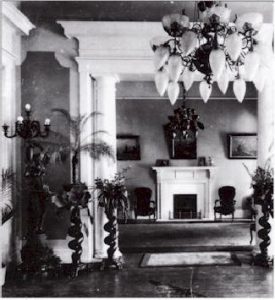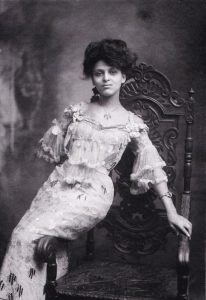If an individual wanted to indulge oneself with a countess in New Orleans they would reference the Blue Book. It was a circulated directory that advertised a diverse selection of madames and their workers. During the Storyville period in New Orleans, Louisiana, Lulu White, the self-proclaimed Queen of Demi-Monde, was described as:
“Nowhere in this country will you find a more popular personage than Madame White, who is noted as being the most handsome octoroon in America. Her mansion possesses some of the most costly oil paintings in the Southern century. Her mirror parlor is also a dream. There’s always something new at Lulu White’s that will interest yo u. ‘Good time’ is her motto.”
u. ‘Good time’ is her motto.”

Lulu Hendley. real name
Because the Blue Book advertised beauty, photographs of the women would be included in the booklets. It’s rumored that the picture of Miss White in her biography wasn’t her at all but another woman named Victoria Hall, who was also an octoroon. Other women in her parlor were: Clara Miller, Estelle Russell, Sadie Reed, and Sadie Levy. White maintained an opulent ‘OctoroonParlour’ named Mahogany Hall at 235 Basin Street until it was forcibly closed in 1917. Her parlor housed biracial/ Creole women whose patrons were exclusively white men who liked to wallow in the antebellum fantasy. As sick as the need for them to have dominance over a light complexion black women, Lulu knew that their desires would pay off which caused her to invest what would now equate to one million dollars today. Her building would house at least 40 women and 5 parlors. The Mirrored Parlor was notorious because “it allowed the male gave and the black female body to be further objectified and hypersexualized with the many mirrors’ reflective qualities.” E.J. Bellocq, a popular photographer, could attest to the beauty of White’s parlor home and has captured beautiful images of the furniture, chandeliers, potted ferns, Tiffany stained glass windows, and various costly oil paintings that were still intact. The pianists that performed for the clients in Mahogany Hall were Kid Ross, Tony Jackson, and Jelly Roll Morton. After the closing of Storyville on November 12, 1917, White was no longer the belle of the ball as she once was. She was charged multiple times for selling alcohol without a license, prostituting, and attempted murder; however, never really did any jail time during her reign in Storyville. 
The time her charges stuck and she did time was when she was prostituting near a military base which was against the Draft Act. In the mid-1940s, Mahogany Hall was used as a House for the Unemployed before being destroyed in 1949. The edifice was one of the last serving brothel structures to be destroyed in the region.
Sources used:
https://awomantoknow.substack.com/p/a-woman-to-know-lulu-white
https://64parishes.org/entry/lulu-white
From Storyville to Electric Scooters: The Legacy of Race and Sex in New Orleans
https://maggiemcneill.com/2011/09/03/lulu-white/
https://www.nola.com/entertainment_life/arts/article_55423f8a-6365-55d7-859a-2c4d62d61b3d.html